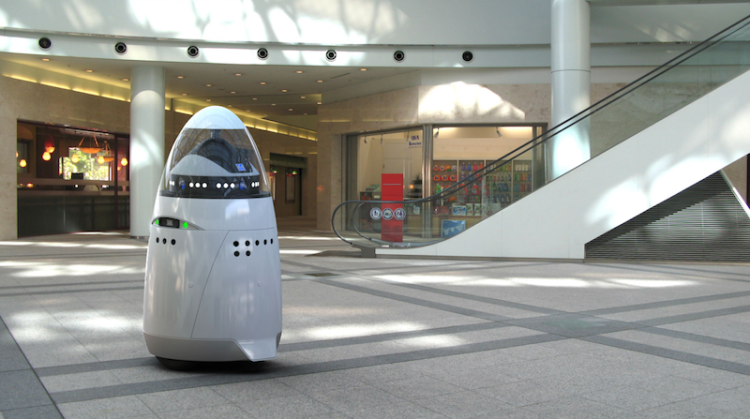Acting like RoboCop’s little brother and looking like R2-D2’s cousin, the K5 crime-fighting robot could be the first in a new wave of Robots-as-a-Service. Proud parent Knightscope is riding that wave, announcing this week that it is oversubscribed on its million-dollar seed round.
Founder and CEO William Santana Li, a former Ford Company executive, told VentureBeat that the largest investor in the seed round is NTT DoCoMo Ventures, part of the Japanese telecommunications giant.
The company’s goal is nothing less than cutting crime in half for K5-patrolled areas, Li said, adding that Knightscope has been “flooded with interest, including 30 massive potential clients.” The initial need for the funding: beta testing with two, unnamed “major clients” in Silicon Valley. Knightscope has said it is initially targeting such markets as corporate campuses, vacant warehouses, schools, hotels, stadiums, and airports.
The five-foot-tall K5 Autonomous Data Machine works sleeplessly, combining massive data capture, predictive analytics, social media analysis, and autonomous navigational technology that the company has compared to Google’s self-driving cars.
In short, Knightscope said, K5 can “see, feel, hear, and smell.”
And scan for crime. The portly fellow can run 300 license plates in a minute, analyze social media for tips on nearby security threats, or recognize threatening gestures. Its arsenal includes day and night 360-degree video, infrared and thermal scanning, promixity sensors, radar for real-time 3D mapping, and optical character recognition.
Rent-a-Cop
“Data collected through these sensors,” the company says on its website, “is processed through our predictive analytics engine, combined with existing business, government and crowdsourced social data sets, and subsequently assigned an alert level that determines when the community and the authorities should be notified of a concern.”
If some areas need the attention of carbon-based police units, K5 generates and transmits a heat map. And, if you try to cow-tip this guy, get ready for an ear-piercing sound.
If it catches on, K5 could do more than become the eyes-and-ears of security and police departments. Knightscope wants to offer the unit as a literal rent-a-cop, available for booking in shifts that don’t need meal breaks.
Of course, there’s the matter of gliding, nearly omniscient, sleepless droids recognizing everyone’s face and pumping out terabytes of data on everything nearby — criminal or not.
Li told us that “any massive disruptive innovation is always going to instill fear.” But he sees K5 as being more of a community portal than a spy.
“After the Boston Marathon bombing,” he said, “everyone tried to help, but there was no effective way to crowdsource.” If K5 had been on duty then, Li said, and the alert was triggered, its terabytes of data “would have been opened up for everyone in the community to see what’s going on.”
Crowdsourcing on reams of site data could solve some problems, but the key question is one that massive reams of data alone cannot solve:
Can an all-knowing sensor-bot be controlled and trusted?
VentureBeat's mission is to be a digital town square for technical decision-makers to gain knowledge about transformative enterprise technology and transact. Learn More

